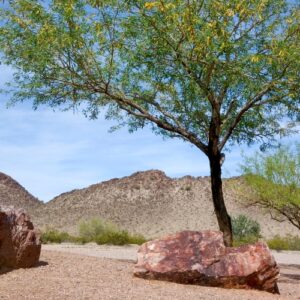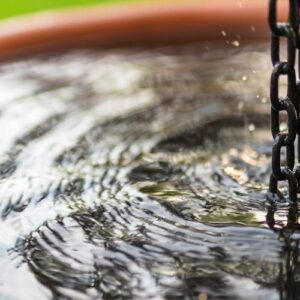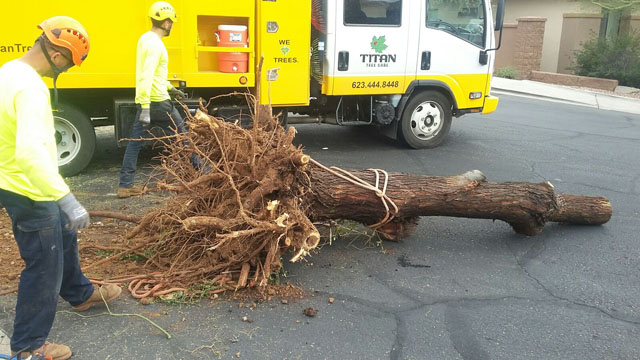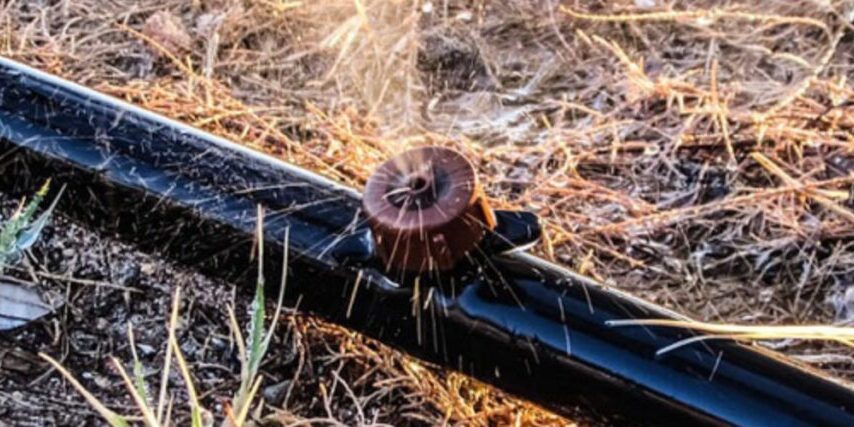
As North Phoenix temperatures begin their dramatic shift from scorching 115°F summer highs to comfortable 75°F fall weather, many homeowners in Anthem, Desert Ridge, Norterra, and the surrounding communities face a critical question: when and how should you adjust your tree watering routine? This transition period often proves more challenging than summer’s intense heat, as trees require careful schedule modifications to stay healthy without becoming overwatered.
Getting this transition wrong can stress desert trees just when they’re preparing for their dormant season. Master this timing, however, and your trees will enter winter healthier, more resilient, and better positioned for strong spring growth while you save money on water costs.
Key Takeaways
- Begin reducing watering frequency when nighttime temperatures consistently drop below 85°F, typically occurring mid-October in North Phoenix areas.
- Residents in communities above 2,200 feet elevation (like Anthem) should start transitions 1-2 weeks earlier than central Phoenix areas due to faster temperature drops and different evaporation rates.
- Palo verde and mesquite trees can handle faster watering reductions than citrus trees, which need gradual 2–3-week transition periods to avoid leaf drop and stress.
- Test soil moisture 6-8 inches deep using the finger test or moisture meters before adjusting schedules, especially in clay-heavy areas, like Desert Ridge, where water retention differs.
- Avoid stopping summer watering abruptly or continuing excessive irrigation when trees no longer need it, as both approaches stress desert trees during fall transitions.
Why It’s Important to Adjust Your Watering Schedule with the Seasons
The key to successful fall watering transitions lies in watching temperature patterns rather than calendar dates. North Phoenix’s unique elevation changes and microclimate variations also mean different timing for different neighborhoods.
Understanding how trees process water helps explain why timing matters so much. Trees “drink” water by pulling it from the soil through their roots and moving it upward to their leaves, where it’s released as water vapor through a process called transpiration. During hot weather, trees pull water rapidly to cool themselves through their leaves, like how people sweat more when it’s hot. As temperatures drop, trees naturally slow down this water-processing because they don’t need as much cooling.
If you keep providing summer-level water when trees have slowed their uptake, the excess sits in the soil and can cause root problems.
When to Start Reducing Tree Watering in Phoenix
Successful fall watering transitions depend on recognizing specific temperature thresholds that tell you when your trees are ready for schedule changes. In North Phoenix’s varied terrain, these critical signals arrive at different times across elevation zones, but the temperature markers themselves remain consistent and easy to identify once you know what to watch for.
Temperature Signs That Tell You It’s Time to Adjust Your Watering
Start monitoring nighttime temperatures in early October. When lows consistently stay below 85°F for five consecutive nights, it’s time to begin your watering transition. Most desert-adapted trees naturally reduce their water uptake when temperatures reach this threshold.
Daytime highs provide the secondary signal. Once afternoon temperatures regularly stay below 95°F, trees begin reducing their water uptake significantly. The evaporation rate from soil surfaces also drops dramatically during this phase.
Expert Insight: “I always tell our clients to watch their trees, not just the thermometer. For instance, a healthy palo verde will show you when it’s ready for less water – the leaves start looking less stressed during the hottest part of the day, even with reduced irrigation.” -Aaron Eubank, Owner, Titan Tree Care
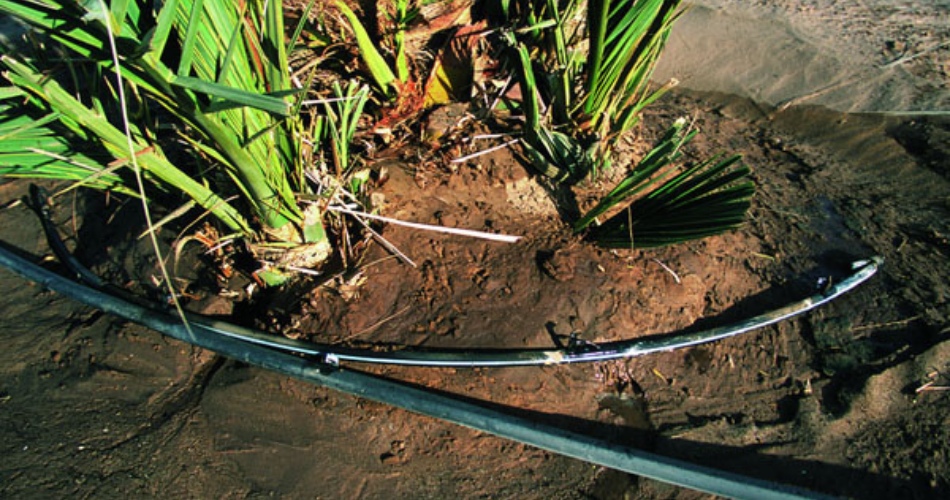
Proper irrigation system setup applies to all desert plants; the same fall watering principles that protect trees also benefit palms and other landscape elements throughout North Phoenix properties.
Fall Tree Watering Schedule: October Through December
It’s important to remember that a successful fall watering transition follows temperature-based milestones rather than rigid calendar dates. Use these frameworks to adjust your specific watering schedule based on your neighborhood’s microclimate and tree species.
| Tree Type | Current Summer Schedule | Phase 1: Early October (Nighttime Lows ≈ 85°F) |
Phase 2: Mid–October (Daytime Highs < 95°F) |
Phase 3: Late Oct–Nov (Nighttime Lows < 75°F) |
Phase 4: December (Dormant Season Prep) |
|---|---|---|---|---|---|
| Desert Natives (Palo Verde, Mesquite) |
Every 3–4 days | Reduce 25% → Every 4–5 days |
Reduce another 25% → Every 5–6 days |
Reduce to maintenance level → 1–2× weekly | Dormancy level → Weekly during warm periods
Weather-dependent → 2× weekly during warm spells |
| Citrus Trees | Every 2–3 days | Reduce 15% → Every 3 days |
Reduce 20–25% → Every 3–4 days | Final reduction → Every 4–5 days | Weather-dependent → 2× weekly during warm spells |
| Shade Trees | Daily | Maintain daily until highs drop <95°F | Begin 15–20% reduction → Every other day | Settle into fall pattern → Every 3–4 days | Moderate reduction → Every 4–5 days |
| Young Trees (All Species) | Varies by species | Reduce 10% → Slightly less than summer |
Reduce another 10% → Gradual decrease |
Final fall adjustment → Slightly more frequent than mature trees | Minimal reduction → Monitor for establishment |
How to Test Soil Moisture for Desert Trees
Accurate soil moisture testing becomes critical during fall transitions because trees often don’t show visible signs of stress until water problems have already developed. North Phoenix’s diverse soil types require different testing approaches to get reliable readings.
Finger Test
The finger test remains the most reliable method for most homeowners:
- Insert your finger or a long screwdriver 6-8 inches into the soil near your tree’s drip line
- If you encounter dry soil at this depth, water regardless of your schedule
- In clay-heavy areas, like parts of Desert Ridge and Anthem, dig a small hole for accurate assessment
- Take readings from multiple locations around each tree to account for uneven irrigation distribution
Moisture Meter
Moisture meters provide more consistent readings, especially in challenging soil types:
- Look for meters that read to at least 8-inch depths
- Calibrate according to manufacturer instructions
- Take multiple readings around each tree’s drip line to account for uneven water distribution from drip irrigation systems
- Watch for false readings in caliche soil layers (hardened layers of calcium carbonate that form naturally in desert soils)
Visual and Physical Soil Assessment
Learn to recognize proper soil moisture levels through observation:
- Properly Moist Soil: Feels slightly damp but not muddy when squeezed.
- Overwatered Soil: Feels sticky, may have slight ammonia smell.
- Underwatered Soil: Appears dusty and feels completely dry.
- Caliche Complications: Hard layers may prevent water penetration despite surface moisture.
Professional Tip: Caliche soil layers, common throughout North Phoenix, can create false moisture readings. If your meter shows wet conditions but the surface appears dry, check for hardpan layers that may be preventing proper water penetration.
Tree Watering Mistakes That Stress Desert Trees
Transitioning to a fall watering schedule presents unique challenges that catch many North Phoenix homeowners off guard. Understanding some of the common mistakes helps you avoid stressing your trees during this critical adjustment period.
Timing and Frequency Errors
The most frequent mistakes involve dramatic schedule changes:
- Stopping Summer Schedules Too Abruptly: Trees need gradual reductions over 2-3 weeks to avoid shock.
- Continuing Excessive Summer Watering: Overwatering leads to root rot in clay soils once temperatures drop.
- Following Calendar Dates Instead of Temperatures: Weather patterns vary year to year, making calendar dates an unreliable gauge.
Irrigation System and Technique Problems
Technical aspects of watering often cause transition difficulties:
- Not Adjusting Watering Duration: As you reduce watering frequency during fall transitions, each irrigation session should provide deeper, more thorough watering to encourage proper root development rather than maintaining the same short runtime used during summer’s frequent watering.
- Failing to Check Emitter Output: Cooler temperatures reveal clogged or uneven distribution patterns that weren’t obvious during hot summer months when water evaporated quickly, making fall the ideal time to inspect and repair irrigation systems.
- Inadequate Mulching: Missing opportunities to regulate soil temperature and moisture levels makes watering transitions less effective, as proper mulch around trees helps buffer temperature changes and reduces evaporation during schedule adjustments.
- Mulch Placement Errors: Placing mulch directly against tree trunks promotes problems with pests and disease by creating consistently moist conditions where bark meets soil. To prevent this, maintain a 3–6-inch gap between the mulch and the trunk.
Not Considering Your Area’s Specific Characteristics
Each North Phoenix neighborhood presents unique challenges and considerations for fall tree watering transitions. Understanding your area’s specific characteristics, from elevation and soil composition to development age and tree maturity, helps you fine-tune your watering approach for optimal results.
While general temperature guidelines apply across the region, successful transitions account for the microclimates and conditions specific to your property and community.
Overlooking How Elevation Affects Tree Watering Schedules
Elevation significantly affects both temperature patterns and evaporation rates, which directly impact when trees reduce their water uptake. Higher elevations cool faster and experience different humidity levels, meaning trees at different elevations need watering adjustments at different times.
Here’s how temperature-based timing varies across several North Phoenix elevation zones:
- Anthem and Higher Elevations (2,200+ feet): Transitions typically begin around October 15th.
- Desert Ridge and Norterra (1,200-1,500 feet): Usually start transitions October 20-25th.
- Arcadia and Central Phoenix Areas (1,100 feet): Often begin transitions by early November.
Avoid This Common Mistake: Shallow, frequent watering during fall transitions promotes weak surface root growth just when trees need deeper, stronger root systems for winter preparation.
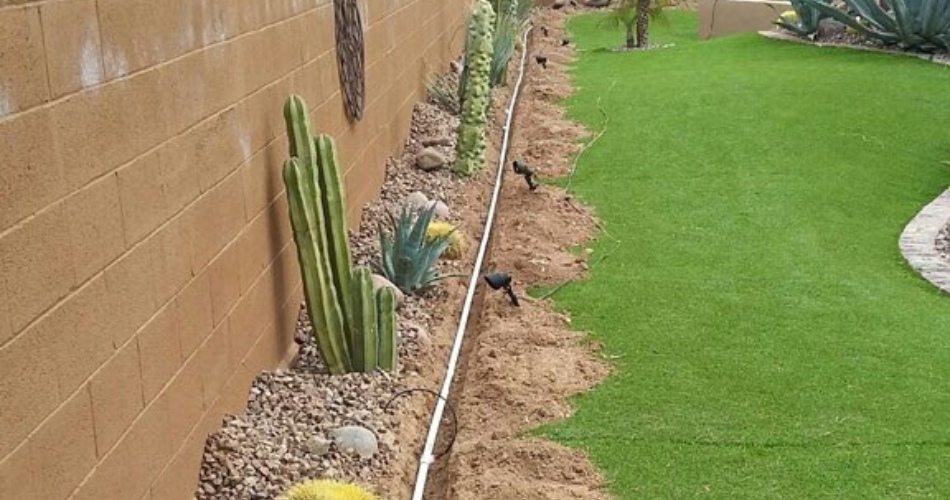
Properly designed irrigation systems with separate zones for trees, desert plants, and turf allow for the customized fall watering adjustments each plant type requires, ensuring North Phoenix landscapes transition successfully through temperature changes.
Frequently Asked Questions About Fall Tree Watering in Phoenix
How do I know my fall watering transition is working correctly for my trees?
Healthy transitions show trees maintaining normal leaf color without afternoon wilting, soil that feels appropriately moist 6-8 inches deep, and no signs of new pest activity or fungal growth around tree bases. Trees should look less stressed during hot afternoon periods as they adapt to reduced watering.
What should I do if my automatic irrigation system doesn’t allow gradual reductions?
Most modern irrigation controllers allow percentage adjustments; reduce runtime by 25% increments rather than changing frequency. If your system only allows on/off scheduling, manually turn off zones on specific days to create gradual reductions, or consider upgrading to a smart controller with seasonal adjustment features.
Is it normal for some leaf drop during fall watering transitions?
Some leaf drop is normal for deciduous trees preparing for dormancy. Palo verde trees, which are semi-deciduous, naturally shed some leaves during fall as well. However, excessive or sudden leaf drop beyond normal seasonal patterns may indicate transition stress. If you see significant unexpected leaf loss, slow your transition schedule and check soil moisture levels more frequently.
Should I fertilize my trees during the fall watering transition period?
Avoid fertilizing during active watering transitions as this can stress trees adapting to new moisture levels. Plan fertilization for either early fall before transitions begin or wait until trees have fully adapted to their new schedules, typically after the November transition period completes.
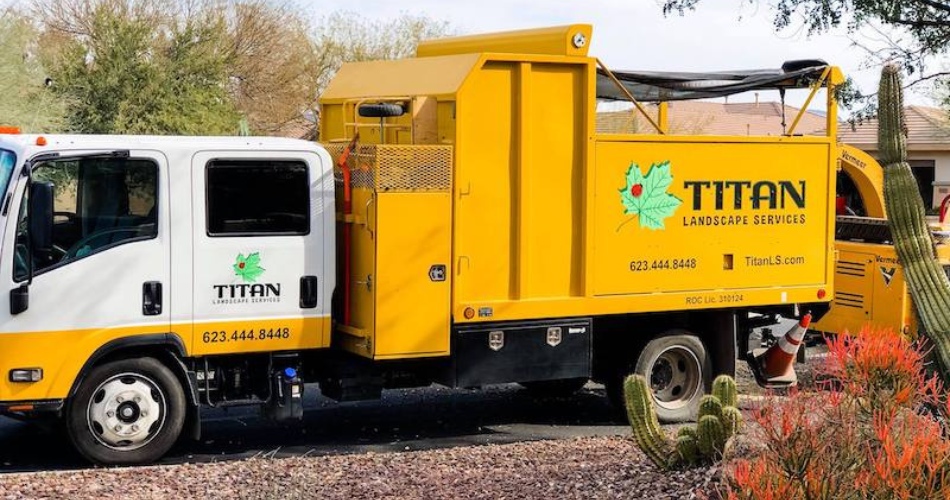
Master Fall Tree Watering in North Phoenix With Help from Titan Tree Care
Navigating fall watering transitions can be tricky, especially with North Phoenix’s diverse microclimates and soil types. At Titan Tree Care, we provide honest, educational consultations to help you care for your trees properly without unnecessary upselling.
Our ISA Certified Arborist offers free tree health consultations throughout Anthem, Desert Ridge, Norterra, Tramonto, and surrounding North Phoenix areas. We’ll assess your specific trees, soil conditions, and irrigation setup to create a customized fall care plan.
Call 623-444-8448 to schedule your free consultation or request an estimate online to get started today.
More Articles Like This

Titan Tree Care is a full-service tree care company located in Anthem, AZ and serving all of North Phoenix. We offer a wide range of services to meet your tree care needs, including tree and palm trimming, tree pruning, tree removal, stump grinding, and more. We also offer insect or disease treatments and fertilization services. We are dedicated to providing high-quality, safe, and effective tree care services to our customers and work hard to ensure that your trees are healthy and look their best.



